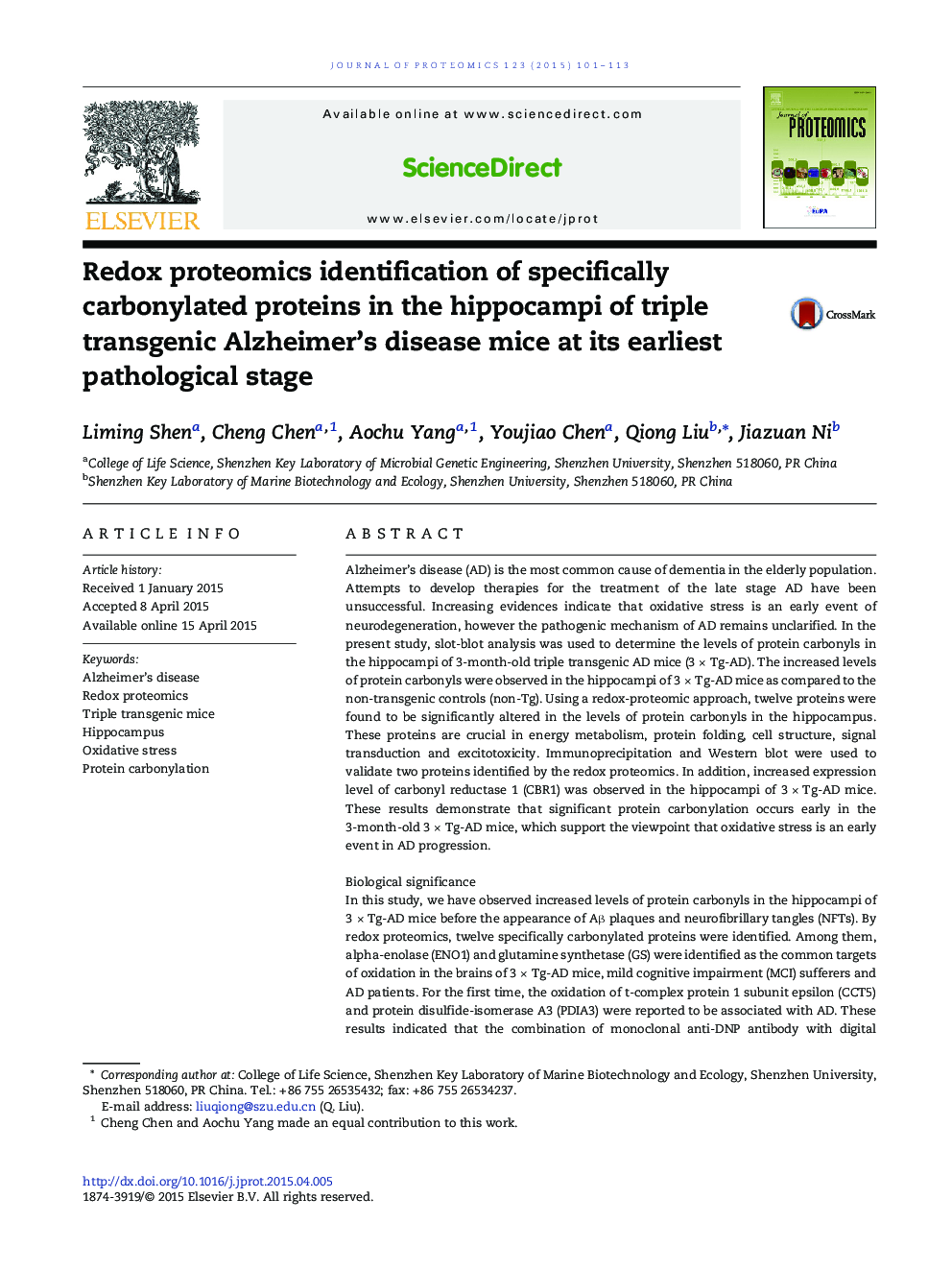| کد مقاله | کد نشریه | سال انتشار | مقاله انگلیسی | نسخه تمام متن |
|---|---|---|---|---|
| 1226069 | 1494757 | 2015 | 13 صفحه PDF | دانلود رایگان |

• For the first time, increased protein carbonyls were observed in the hippocampi of 3 × Tg-AD mice early at 3 months of age.
• ENO1 and GS are the common targets of oxidation in the brains of 3 × Tg-AD mice, MCI and AD patients.
• For the first time, CCT5 and PDIA3 were identified as specifically carbonylated proteins linked to AD.
• Due to the elevated carbonyls, increased expression of CBR1 was observed in the hippocampi of 3 × Tg-AD mice.
• Oxidative stress is an early event in the pathogenesis of AD.
Alzheimer's disease (AD) is the most common cause of dementia in the elderly population. Attempts to develop therapies for the treatment of the late stage AD have been unsuccessful. Increasing evidences indicate that oxidative stress is an early event of neurodegeneration, however the pathogenic mechanism of AD remains unclarified. In the present study, slot-blot analysis was used to determine the levels of protein carbonyls in the hippocampi of 3-month-old triple transgenic AD mice (3 × Tg-AD). The increased levels of protein carbonyls were observed in the hippocampi of 3 × Tg-AD mice as compared to the non-transgenic controls (non-Tg). Using a redox-proteomic approach, twelve proteins were found to be significantly altered in the levels of protein carbonyls in the hippocampus. These proteins are crucial in energy metabolism, protein folding, cell structure, signal transduction and excitotoxicity. Immunoprecipitation and Western blot were used to validate two proteins identified by the redox proteomics. In addition, increased expression level of carbonyl reductase 1 (CBR1) was observed in the hippocampi of 3 × Tg-AD mice. These results demonstrate that significant protein carbonylation occurs early in the 3-month-old 3 × Tg-AD mice, which support the viewpoint that oxidative stress is an early event in AD progression.Biological significanceIn this study, we have observed increased levels of protein carbonyls in the hippocampi of 3 × Tg-AD mice before the appearance of Aβ plaques and neurofibrillary tangles (NFTs). By redox proteomics, twelve specifically carbonylated proteins were identified. Among them, alpha-enolase (ENO1) and glutamine synthetase (GS) were identified as the common targets of oxidation in the brains of 3 × Tg-AD mice, mild cognitive impairment (MCI) sufferers and AD patients. For the first time, the oxidation of t-complex protein 1 subunit epsilon (CCT5) and protein disulfide-isomerase A3 (PDIA3) were reported to be associated with AD. These results indicated that the combination of monoclonal anti-DNP antibody with digital imaging system could enhance the specificity and accuracy of redox proteomics analysis. Those data support the viewpoint that oxidative stress occurs at the early pathological stage of AD. In addition, this paper provides new information for understanding the pathological process of AD and for developing more appropriate therapies to intervene AD progression.
Figure optionsDownload high-quality image (244 K)Download as PowerPoint slide
Journal: Journal of Proteomics - Volume 123, 18 June 2015, Pages 101–113